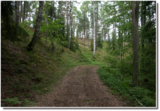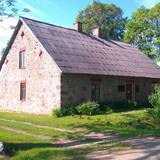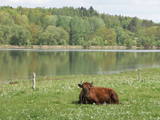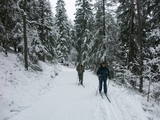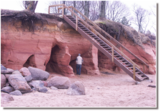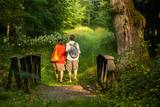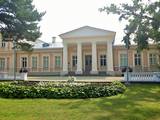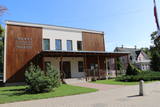| Нo | Название | Описание |
|---|---|---|
|
В Ошвалки – населенном месте между Юркалне и Сарнате установлен памятный знак «Парус надежды», посвященный тем латышским беженцам (1944 – 1945), которые на рыбацких лодках отправились через Балтийское море в Швецию. Знак установлен на прибрежной дюне между дорогой и морем. |
||
|
From the tower of St Simon’s Lutheran Church, you can see the central part of Valmiera and the banks of the Gauja River. During clear weather, you can see Zilaiskalns Hill. The church contains some cultural and historical treasures, as well as one of Latvia’s most resonant pipe organs.
|
||
|
The classical skyline of Old Rīga can be enjoyed from several locations – Mūkusalas Street, between the railroad bridge and the stone bridge, from the stone bridge, from the A-B dam, from the grounds of the central office of the Swedbank bank, from the Vanšu bridge, and from the Ballast Dam at Ķīpsala. You can hike or bike from location to location. During the summer, little ships cruise up and down the Daugava to offer different views.
|
||
|
Коллекция велосипедов отца и сына Ивана и Гунта Серегиных, единственная коллекция старинных велосипедов в Латвии и самая большая в Балтии, которую уже несколько лет можно осмотреть в созданном своими силами музее. Коллекция старинных велосипедов укомплектована из технически самых интересных найденных в Латвии образцов развития велосипедной истории. В общей сложности в музее находится около 70 изготовленных и использованных в Латвии велосипедов. Наряду с велосипедами в музее широко представлены различные вещи, связанные с использованием велосипедов, велосипедным спортом, обществами велосипедистов и производством велосипедов. В экспозиции представлена также самая большая коллекция значков велосипедных фирм в Восточной Европе - более чем 1000 эмблем со всего мира. Предлагаются экскурсии в сопровождении гида. |
||
|
This tour offers seeing the capital cities and most attractive towns of Lithuania, Latvia and Estonia through the freedom of independent travel and using public train and bus services. Getting around in cities and towns is easy, either by walking, or by using local public transport or taxis. The Old Town of Vilnius is in the UNESCO World's Cultural Heritage list. Daugavpils Fortress and the museum of Mark Rothko, the world famous abstractionist, are two highlights of Daugavpils city, Rēzekne city is known as the heart of Latgale region. Riga, the capital city of Latvia, offers a variety of cultural experiences and entertainment. Sigulda is famous for its landscapes and medieval castles. Cēsis is one of the most charming towns in Latvia with many attractions ranging from medieval heritage to nice restaurants, exhibitions and festivals. Valmiera offers art galleries, museums, nature trails and Valmiermuža beer from the famous local brewery. Tartu in Estonia is a university town, with some very popular tourist attractions such as the interactive AHHAA science centre, the largest in Baltic countries. Narva is a border town overlooking the Ivangorod fortress in Russia across the river Narva. Finish the tour in Tallinn – the capital city of Estonia. Tourist information centres in cities and towns will help you with maps, information on sights, attractions and guided tours, food, shopping and public transport. |
||
|
Зеленая дюна – за горами Крачу (Крачкални) второе
выраженное в национальном парке дюнное образование,
которое на протяжении более трех километров отделяет
болото Ведьм от Зеленого болота. У подножья петляет
древняя грунтовая дорога, по которой и проходит
выполняемый маршрут. Идя по Зеленой дюне,
пожалуйста, следуйте только по уже проложенным
тропам!
|
||
|
Operdziedātāja Jāņa Zābera muzejs "Vecais ceplis" atklāts 1973. gada 11. augustā - dziedātāja dzimšanas dienā - viņa dzimtajās mājās. Muzejā apskatāmas fotogrāfijas no viņa dzīves gājuma, afišas un operu tērpi. Tāpat pieejami dziesmu un operu āriju ieraksti mākslinieka izpildījumā. Muzeju pārzina Jāņa Zābera brāļa meita ar ģimeni. To ir iespējams apmeklēt, iepriekš saskaņojot laikus.
|
||
|
The nature park in the Daugava River valley is the only place between the cascades of the Daugava hydroelectric power plants there is still a chance to see the Daugava River valley and the ravines of its tributaries as they appeared before the area was flooded so that the power plants could be constructed. Particularly lovely views are found on the right bank of the river near the Aizkraukle church and castle hill. Forests, meadows, origins of streams and small dolomite cliffs in this area are all protected biotopes. Leisure facilities have been installed on the Aizkraukle castle hill, and the Aizkraukle castle ruins are not far away. |
||
|
Находится в центральной части Екабпилса. Пекут пиццы, сдобные булочки, пирожные, торты и крендели. Предлагают копчености, деликатесы из оленины и кабана, продукты местных надомников и крестьян. |
||
|
The nature park near the town of Ogre is a popular place for leisure, hiking and, in the winter, cross-country skiing. Most of the park is covered with coniferous trees that are on a long and comparatively narrow line of hillocks with steep sides – another element of nature left behind in Latvia by the Ice Age. Many different plants can be found here. The Jaunogres castle hill is one of the most distinct hillocks in the area. |
||
|
Ainavisks jūras viļņu izskalots smilšakmens atsegums
dienvidos no Zaķupes ietekas.
|
||
|
Межа мая – здание, построенное в 1933 г.,
является одним из самых ярких строений
национального романтизма в Латвии.
Первоначально здание служило в качестве
широко известного в округе ресторана "Яутрайс
одс" ("Веселый комар"). После Второй мировой
войны в здании разместился детский санаторий
"Межа мая" (Лесной дом). С 1997 г. с
созданием Кемерского национального парка,
"Межа мая" стало зданием администрации и
одновременно современным центром для
посетителей, а также местом проведения
различных экологопросветительских
мероприятий.
|
||
|
Хозяева выращивают шиншилл (родина шиншилл – горы Анды Южной Америки). Предлагают экскурсию и рассказ о жизни и выращивании шиншилл, приобретение животных и шкурок. Хозяйка пишет картины. |
||
|
Tāpat kā Ventspils Rātslaukums, arī Tirgus laukums ir uzskatāms par pilsētas vēsturiskā centra nozīmīgu daļu, kura apkaimē ir saglabājies senais ielu plānojums. Kādreizējā Rātsnama vietā tagad slejas kariljonu zvana pulksteņu tornis. Tas zvana katru stundu, bet 12:33:44 un 00:33:44 ar īpašu melodiju ieskandina astronomisko Ventspils laiku. Tirgus laukumā ir aka, kas saulainā laikā darbojas arī kā Saules pulkstenis. Monētu automātā var izkalt īpašu piemiņas monētu. |
||
|
Located in one of the most untouched corners of northern Latgale. Already from the spring they offer worker bee and later both, young and producing bee, propolis and wax mixture candles, pollen bread and propolis in butter. The workshop produces bee hives and other apiary equipment. |
||
|
The Ungurmuiža park is well known for its outstanding and huge oak trees. Some of them are rotting or dead, and they are home to a great many species, including many that are found nowhere else in Europe. A pathway leads through these noble trees – 1.3km in length, with visitors spending as much as an hour there. The park also contains the only wooden castle from the early 18th century that has been preserved to the present day. There are other cultural and historical treasures, as well.
|
||
|
Парк усадьбы Ренавас, заложенный в XIX в., представляет собой один из литовских парков репрезентативного типа и сохранил свое первичное природное начало. В небольшом партере дворцовой части парка сохранилось немало экзотических пород деревьев. В северной части парка и в лесопарковой зоне преобладают клены, липы, ясени, ели, дубы и др. Украшением парка является самая толстая ель в Литве: ствол этого дерева достигает 1,2 м в диаметре. Также здесь растет необычная липа: ее главный ствол некогда сильно накренился, и сейчас на нем растут шесть отдельных деревьев, отпочковавшихся от основного ствола. В парк ведет так называемая пергола (крытая аллея), увитая вьюнком. |
||
|
Находится на ул. Бривибас, д. 15, Огре (в здании Дома культуры). В музее (учрежден в 1980 г.) представлена постоянная экспозиция «Огре - купальный и воздушный курорт. Отдых и быт в 1920 – 1940 гг.», которая наглядно отображает время цветения Огре, когда город был популярным курортом. Вторая экспозиция «Легендарный Огре» предлагает посетителям нетрадиционный взгляд на события города. |
||
|
Расположенная в Лахемааском национальном парке рыбацкая деревня Алтъя впервые упоминается в 1465 году. Это типичная прибрежная деревня, где дома расположены вдоль одной деревенской улицы. Сегодня здесь можно увидеть типичные прибрежные хутора конца 19-го века-Уусталу и Тоомарахва. На мысе Алтъя восстановлены сараи для сетей. В деревне есть качели, национальные блюда предлагает ресторан Altja kõrts/Корчма Алтъя (+372 501 4287, www.palmse.ee/altja-korts) |
||
|
Latvia is the land of apples, so producing cider here is only natural! The ancient traditions of apple growing in our country, as well as the variety of high-quality apple cultivars, are key advantages of Latvia's cider culture. In our climate zone, it is challenging to grow good grapes for wine production, but the local conditions are particularly suitable for making apple cider. This is a natural consequence that local cider producers are increasingly mastering with excellence. The Cider Route will take you to various cideries in Latvia, as well as to restaurants and pubs that serve it. The Cider Route allows you to understand the specifics of Latvian cider, introducing you to the culinary traditions and cultural heritage of different regions. You will have the opportunity to meet the cider makers themselves, who run small farms, tend to the orchards, share about their work, and even let you participate in it. |
||







